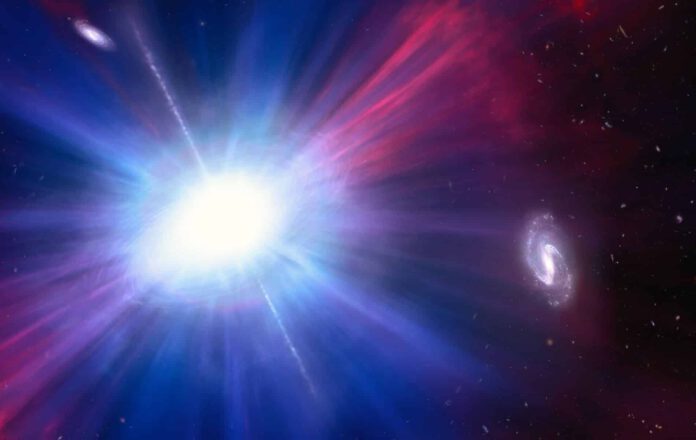
Astronomers Spot Another Mysterious ‘Blue Burst’
Astronomers have once again observed a rare and enigmatic ‘blue burst.’ This discovery further amplifies the mystery surrounding this type of cosmic explosion.
An Intriguing Discovery
An extraordinarily bright flare in the universe, already very rare and unusual, has just become even more mysterious. Astronomers have spotted another ‘blue burst’ (Luminous Fast Blue Optical Transients, or LFOTs). But what makes this discovery so remarkable is that the event was not located where it is typically expected – within a star-producing region – but surprisingly outside of it.
The Finch
Since the bursts emerge quickly and also fade swiftly, astronomers maintain their search for them using telescopes that continuously monitor large sections of the sky. ‘The Finch’ was tracked down using the Zwicky Transient Facility, a telescope that charts the entire northern sky every two days. After the Finch was first detected, the event was observed by different telescopes spanning various parts of the electromagnetic spectrum, from X-rays to radio waves. However, it was ultimately the remarkably sharp resolution of the Hubble telescope that enabled scientists to determine the precise location of the newly discovered LFOT.
Characteristics
The Finch exhibited all the characteristic features of an LFOT, such as an intense emission of blue light and rapid evolution where it promptly reached its maximum brightness and then faded within a few days. Spectroscopic measurements conducted with the Gemini South telescope in Chile revealed that the Finch had an incredibly high temperature, a scorching 20,000 degrees Celsius (36,032 degrees Fahrenheit). But unlike other LFOTs previously observed, the Finch appeared in an entirely unexpected location, far from any galaxy. This is peculiar since all previous LFOTs were discovered in the spiral arms of galaxies where new stars were currently being formed.
Unexpected Location
However, Hubble discovered that the Finch is located precisely between two neighboring galaxies. It is at a distance of about 50,000 light years from a nearby spiral galaxy and about 15,000 light years from a smaller galaxy. This is a rather confusing location, as cosmic events like these are usually thought to occur within galaxies. “The observations made with the Hubble telescope are invaluable,” explains team leader Ashley Chrimes. “They led us to realize that this situation is exceptional in comparison to similar cases. Without Hubble’s data, we would have had no idea about these unusual characteristics.”
Explanation
To understand the Finch’s peculiar location, scientists are considering two possible explanations. One is that it was an explosion of an extremely fast-moving star. Another hypothesis is that it originated from the collision of two neutron stars that over billions of years spiraled increasingly closer to each other until they finally collided. “The discovery raises more questions than it answers,” says Chrimes. “More research is required to figure out which of the possible explanations is the correct one.”
A Greater Mystery
Hubble’s findings suggest that astronomers actually understand LFOTs less than initially thoughts. “The more we discover about LFOTs, the more they astonish us,” remarks the researcher. “We’ve now demonstrated that LFOTs can occur a considerable distance from the center of the closest galaxy, which contrasts sharply from what we would normally expect with supernovae.” In the coming years, astronomers hope to discover more of these blue bursts to better understand this phenomenon. Their hopes are pinned, among others, on the currently under-construction Vera C. Rubin Observatory in Chile. This telescope will scan the entire southern sky every few nights, enabling researchers to detect more mysterious LFOTs.











